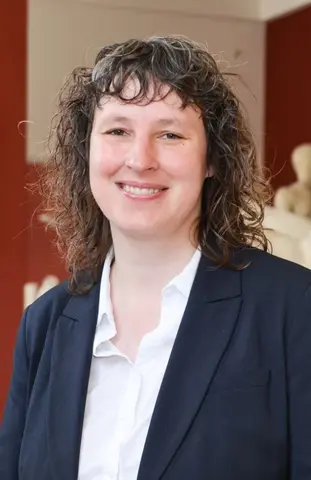Prof. Dr. Annette Haug
annette.haug@uni-erfurt.deFellow (Max Weber Centre for Advanced Cultural and Social Studies)
Visiting address
Max-Weber-Kolleg für kultur- und sozialwissenschaftliche Studien
Campus
Nordhäuser Str. 63
99089 Erfurt
Mailing address
Universität Erfurt
Max-Weber-Kolleg für kultur- und sozialwissenschaftliche Studien
Postfach 90 02 21
99105 Erfurt

Personal information
Annette Haug holds the Chair of Classical Archaeology at Christian-Albrechts-Universität zu Kiel. Her research interests concern visual culture studies and aspects of urban lifestyles and urban design. Her bi-national PhD (Heidelberg/Paris) was published under the title „Die Stadt als Lebensraum. Eine kulturhistorische Analyse zum spätantiken Stadtleben in Norditalien“ (2003). In 2009, she completed her habilitation, „Körper- und Rollenbilder im Athen des 8. und 7. Jh. v. Chr.” at Leipzig University. Currently, she is the principal investigator of the ERC Consolidator Grant “Decorative Principles in Late Republican and Early Imperial Italy”.
Education / Appointments
- 1996–1998 Studies of Classical Archaeology, Art History and Prehistory, Ruprecht-Karls-Universität Heidelberg
- 1998–1999 Studies at the Université Paris IV/Université Paris I
- 1999–2000 Studies at the Ruprecht-Karls-Universität Heidelberg
- 07/2000 Research stay at King’s College Cambridge
- 2000–2003 Cotutelle de thèse (binational Phd) Universities of Heidelberg/Paris-Sorbonne;
- 2003–2004 Research stay at the German Archaeological Institute, Rome (Gerda Henkel Fellowship)
- 2004–2005 Travel grant („Reisestipendium“) of the German Archaeological Institute
- 2005–2007 Research Assistant, Institute for Classical Archaeology, University of Leipzig
- 2007–2008 Research Fellow at the University of Oxford, Lincoln College (Feodor Lynen Fellowship)
- 2008–2010 Research Assistant, Institute for Classical Archaeology, University of Leipzig
- 16.06.2009 Habilitation in Classical Archaeology, University of Leipzig
- 2010 „Umhabilitation“, Ludwig-Maximilians-Universität München
- 2010–2012 Heisenberg Fellow, Institut for Classical Archaology, LMU München
- since 2012 Senior Professor for Classical Archaeology (W3), CAU Kiel
Fellowships, Awards, Functions
- 2003 Ruprecht-Karls-Preis of the Universität Heidelberg (University Price for the best PhD of the year in Heidelberg)
- 2003 Juliana-Anicia-Preis (best PhD in the field of Late Antique studies)
- 2003-2004 Gerda Henkel Post-Doc Fellowship, Rome
- 2004-2005 Travel grant („Reisestipendium“) of the German Archaeological Institute
- 2007-2008 Feodor Lynen Fellowship, Alexander-von-Humboldt-Stiftung
- 2010-2012 Heisenberg Fellowship
- 2010-2012 Member of the Centre of Advanced Studies, LMU München
- 2013 Research Stay at the University of Cambridge, Alexander-von-Humboldt-Stiftung
- 2016 Research Stay at the Université Pantheon-Sorbonne, Alexander-von-Humboldt-Stiftung
- 2016–2021 PI of ERC Consolidator Grant „DECOR“
- since 2017 Member of the der Akademie der Wissenschaften zu Hamburg
- 2019 Science price (Wissenschaftspreis) of the city of Kiel
Functions / Collaborative Research Projects
- since 2014 Board Member, Johanna-Mestorf-Akademie Kiel
- 2014-2018 Board Member of the Graduate School “Human Development in Landscapes”
- 2015-2018 Deputee Speaker of the Graduate School “Human Development in Landscapes”
- 2016-2017 Board Member CRC 1266 „TransformationsDimensionen“
- 2016-2018 Deputee Speaker of the Excellence Cluster ROOTS (approved in 2018)
- 2016-2020 PI in three subprojects of the CRC 1266 TransformationsDimensionen
- since 2019 Speaker of the Subcluster Urban ROOTS (of the Excellence Cluster ROOTS)
- since 2019 Board Member of the Excellence Cluster ROOTS
Administrative responsibilities
- since 2012 Board Member of the Freunde der Antike Kiel e.V.
- 2012-2014 Member of the Faculty Board, Faculty of Philosophy, CAU Kiel
- 2014-2016 Director of the Institute of Classics, Kiel
- since 2018 Substitute Member of the Senate, CAU Kiel
- since 2018 Substitute Member of the Faculty Board, Faculty of Philosophy, CAU Kiel
- since 2020 Member of the Senate, CAU Kiel
Service for Research Foundations
- Member of the Senate of the DFG (German Research Foundation)
- Referee for the DFG
- Referee for the Alexander von Humboldt Foundation
- Referee for the Frith Thyssen Foundation
- Referee for the VolkswagenStiftung
- Referee for the DAAD
- Vertrauensdozentin of the Studienstiftung des Deutschen Volkes
Member of International Committees
- Member of the Scientific Board of AHRC-Project Catrin Huber, Newcastle University
- Member of the Scientific Board of Scientific Journal “Flora”, Naples University
- Member of the Scientific Board of Scientific Series “Argonautika”, Parco Archaeologico di Paestum
Research project
Project title: Talking with, about, and in the presence of the Gods: Graffiti in Pompeii
Topic + research questions + case study + methodology:
The aim of the research project is to make everyday interaction with, about, and in the presence of the gods tangible by examining and contextualising graffiti. The case study will focus on late Republican and early Imperial Pompeii (destroyed in A.D. 79) – the city with the absolute best surviving record of ancient wall graffiti. Graffiti is particularly suitable in dealing with such a research question, for three reasons:
• The act of writing graffiti constitutes a form of urban agency. Graffiti not only constitutes a discourse, it is also a part of urban interaction and communication processes in and of itself.
• As a spontaneous and unplanned form of interaction and communication that is not officially regulated, graffiti is close to ‘everyday’ communication.
• Graffiti is related to concrete places by its physical attachment. It is thus possible to understand graffiti in relation to specific places.
Against this background, the project chooses two interdependent approaches. On the one hand, it analyses ritual graffiti and graffiti addressing or mentioning the gods. The project focuses on their positioning within the urban context, their relation to ‘installations’ (e.g. altars, fountains), their positioning in relation to decorative features and their interaction with other forms of script (graffiti; dipinti). On the other hand, the project examines graffiti placed in the ‘presence’ of gods – texts written in sanctuaries or close to ritual installations such as altars. This complementary approach provides an understanding of the communicative habits in sacred places. These two interlinked approaches allow for a new understanding of everyday ritual-religious concepts and actions.

